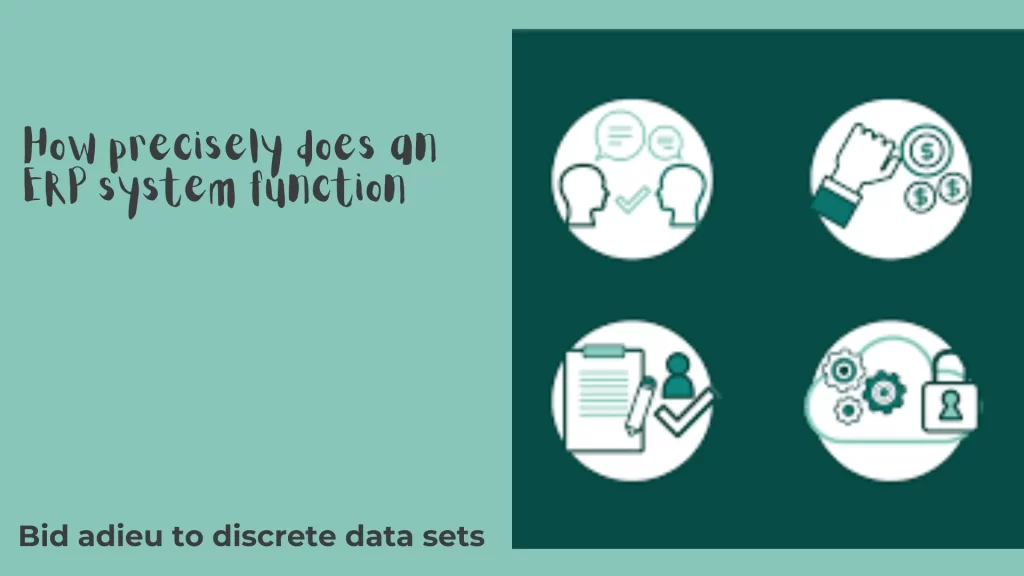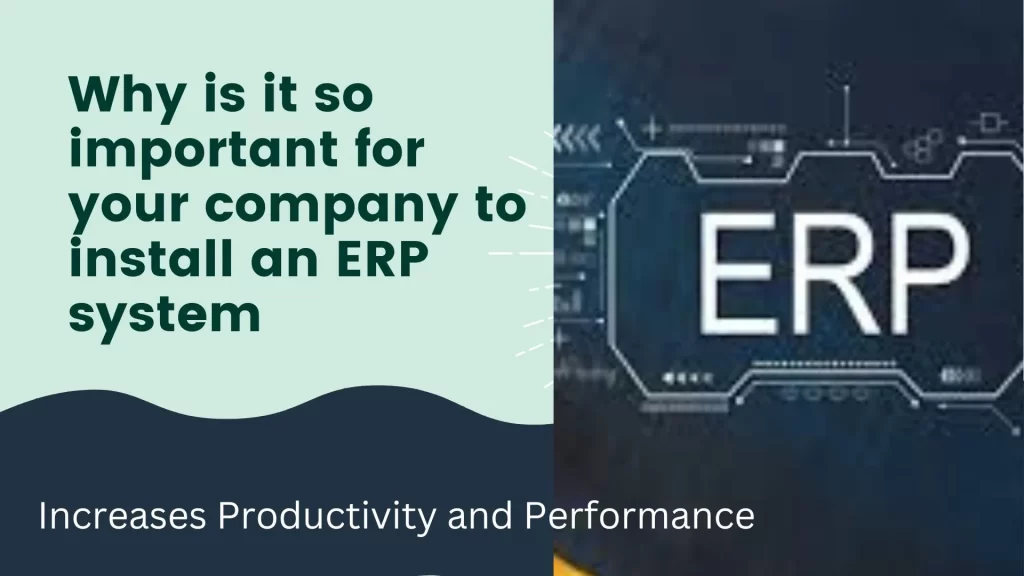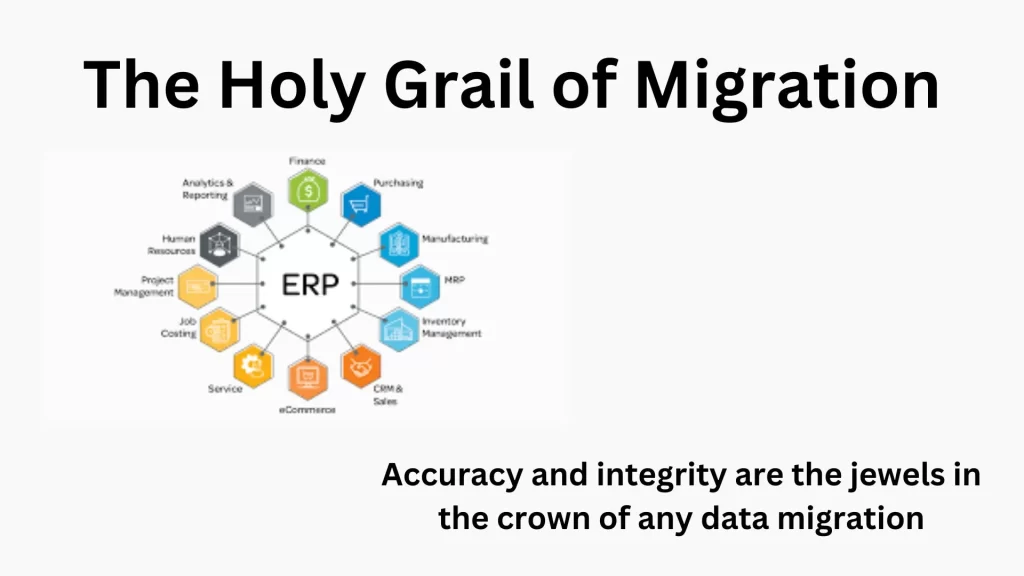
Reasons why your Office needs ERP system
Why Your Company Requires It
Gaining a competitive edge and optimizing processes are critical in today’s hectic corporate environment. Systems for enterprise resource planning, or ERPs, are useful in this situation. Envision an all-encompassing suite of software that can effectively integrate and oversee all of your primary business operations, including finance, accounting, supply chain, inventory, human resources, and customer relationship management (CRM). ERP works like a centralized command center, optimizing your entire business. That’s its magic, and it emphasizes why deploying ERP system in your organization is needed.
How precisely does an ERP system function?

Unifies Data: Bid adieu to discrete data sets! ERP unifies heterogeneous systems to establish a single source of truth for your company as a whole. Duplications, gaps, and the desperate hunt for precise information are all eliminated as a result. By automating tedious tasks like purchase orders, invoice processing, and inventory management, substantial resources and time may be committed to more strategic endeavors. By automating mundane operations like purchase orders, invoice processing, and inventory management, substantial resources and time may be allocated to more strategic endeavors.
You can make well-informed decisions, respond swiftly to changes in the market, and maximize productivity when you have access to real-time data across departments. Consider using a single platform to analyze client behavior, production constraints, and sales trends. When all employees are using the same platform, departmental communication and cooperation are seamless. Finance can comprehend inventory levels, sales teams can monitor production schedules, and marketing may tailor campaigns based on consumer information.
Increases Productivity and Performance: Automation, better data access, and streamlined procedures all contribute to notable increases in productivity and efficiency. This results in reduced expenses, enhanced client support, and a more robust competitive edge.
Why is it so important for your company to install an ERP system?
ERP solutions offer a scalable and adaptable platform that can grow with your company and change to meet changing demands.
Acquiring information and making decisions based on factual evidence Accessing real-time data from many departments allows you to make informed decisions based on factual facts rather than relying on guesswork. Identify areas of underperformance, optimize resource utilization, and properly predict market trends.
Improved operational efficiency results in better overall service, faster deliveries, and a quicker response to customer inquiries. Customer satisfaction leads to client loyalty and business expansion. Process integration and automation boost productivity, cut expenses, and free up time for value-adding and innovation. This gives a substantial advantage over rivals who are still struggling with disjointed systems and manual procedures.
Although putting in and deploying ERP system in your organization requires money, the return on investment is obvious. ERP enables your company to realize its full potential through increased productivity, enhanced decision-making, and a competitive advantage. By embracing the potential of ERP, you can open a world of streamlined operations, data-driven choices, and long-term success. So quit juggling spreadsheets and fragmented data.
Disclosing the Ideal Fit
The key to a successful ERP adoption is choosing the right vendor. Here are some important things to think about:
Does the vendor have knowledge of and expertise with particular solutions designed to meet the needs and challenges of your industry? Evaluate the vendor’s technological prowess, taking into account alternatives for on-premises or cloud deployment, data security protocols, and system uptime assurances. Give preference to suppliers who have a track record of long-term business viability and financial stability. To guarantee a seamless transition and optimize user adoption, does the vendor provide thorough implementation, training, and continuous support services? Speak with current customers to learn valuable details about how they interact with the supplier and the erp system.
Scalability and Functionality: A Partnership of Strength and Expansion
Look more closely at the features and flexibility of the solution after you’ve chosen the best provider. Important things to think about are:
Core Modules: Does the ERP include the key modules that your company requires, like inventory control, customer relationship management (CRM), finance, accounting, and human resources (HR)? Is it possible to modify the solution to fit your unique workflows and procedures, or will you need to make strict adjustments? Can the ERP platform easily adapt to your changing company requirements and volume of data?

Integration Skills: Establishing a Smooth system
The seamless data flow and operational efficiency of an ERP are contingent upon its ability to connect with current systems and applications. These are some inquiries to make:
Third-party connections: Does the ERP include pre-configured or readily configurable connections with payment gateways, point-of-sale systems, and software tailored to your industry using the internet?
API Availability: Is the vendor able to support custom integrations with any future platforms or technologies you could embrace through the introduction of comprehensive APIs and open architecture?
Succinctly, a balanced strategy is essential to choosing the finest ERP solution, taking into account the capabilities of the solution, vendor qualifications, and clients for seamless integration Recall that the ideal ERP is more than just software; it’s a strategic partner that enables your company to prosper in the dynamic business environment. You may choose with confidence the solution that best suits your particular needs and sets the stage for a smooth implementation by carefully weighing these important factors. This will lead your company to a future of efficient operations, quick decisions, and long-term growth.
Data Migration: Linking the Past and Present
Data migration, which is essential to your organization, can be a difficult undertaking, similar to building a dangerous bridge between the known and the unknown. If executed well, though, it turns into a life-changing experience that opens up new doors and simplifies processes. However, completing this journey safely calls for careful planning, a steadfast commitment to data integrity, and reliable backup plans.
Developing a Data Migration Plan
This is what your strategy’s cornerstone is
Describe the systems at the point of entry and the destination, noting any possible conflicts and the integration needs. Choose migration tools based on your technical proficiency, financial constraints, and data volume.
Validation and testing: Make sure the migration process is accurate and find any potential problems by thoroughly testing it on a smaller dataset. To reduce disturbance, communicate with stakeholders and provide users with training on the new system.
The Holy Grail of Migration: Data Accuracy
Accuracy and integrity are the jewels in the crown of any data migration. Take into account these steps to protect this treasure:
Before migrating, thoroughly review your data for errors, duplicates, and inconsistencies to prevent polluting the new system. To prevent misunderstandings, carefully map data items between the source and destination systems. Place checkpoints in place at various stages of the procedure to confirm the accuracy of the data and spot any variations. For accountability and traceability, keep thorough logs of the migration process.
Even the most carefully thought-out migrations might have unanticipated difficulties. Here’s where having strong backup plans serves as a comfort and reassurance-giving backup:
Before, during, and after the migrating process, make full backups of your source data. To capture ongoing changes throughout the migration, implement regular backups. Make sure your backups are comprehensive and easily accessible in case of emergencies by testing them regularly. Create a thorough plan that outlines what to do if data corruption or loss occurs.
Therefore, when data migration is done with a meticulous plan, ongoing attention to data integrity, and solid backup methods, it becomes a bridge to progress instead of a dangerous journey. You can guarantee a smooth transition to a future powered by trustworthy and useful data by making significant investments in meticulous planning, giving data accuracy top priority, and being ready for anything that might come up. Keep in mind that your data is your legacy; therefore, handle its relocation with the consideration and care it demands.

Instruction and Transition Management for Easy Travel
Organizational success hinges on embracing change, although doing so can be tough. Therefore, the systematic integration of change management and training is often essential to undertaking transformative activities. These measures frequently require upskilling staff workers and decreasing opposition. By working together, change management and training may guarantee that changes move smoothly, promoting staff buy-in and optimizing the benefits of new procedures, rules, or technology. The key to achieving accomplishment rests in establishing a training program that works. The first step is to determine the demands of the target audience and the knowledge gaps they must address. Next, the program should be customized to the individual initiative, emphasizing:
Development of skills: Whether it’s learning new software or implementing new communication techniques, provide staff members with the knowledge and resources they need to handle the transition. Clearly and succinctly explain the change, its justification, and how it will affect specific roles and workflows. Anticipate possible worries in advance and offer tools and support systems to deal with them.
Encourage a feeling of collective responsibility and provide staff members with chances to participate in the process of transformation. Building trust requires open communication, transparency, and sincere involvement.
Approach resistance head-on by
Having an open dialogue about worries: Establish a secure environment where staff members may express their worries and actively hear their input.
Assign advocates within the company to spearhead the change and serve as a point of contact and encouragement. Highlighting early adopters and significant anniversaries inspires others and reaffirms the benefits of the transformation.
Controlling the ERP Monster: Preparation and Validation for a Smooth Rollout
The hubs of contemporary firms are enterprise resource planning (ERP) systems, which streamline everything from customer relations and inventory management to finance and human resources. However, implementing a new ERP system might be compared to the daunting task of taming a mythical creature. It requires thorough testing and training to overcome the potential challenges it presents. Adventurers, do not fear! With the information and tips provided in this guide, you can successfully navigate the ERP beast and ensure a seamless installation.
Creating All-Inclusive ERP Training Courses
Creating a training program that works is the first step toward successful change management. Understanding the demands of the desired audience and the knowledge gaps they must fill is the first step. Adjust the program to the particular initiative, emphasizing:
Furthermore, whether it’s learning new software or implementing new communication tactics, it significantly equips staff workers with the knowledge and resources they need to handle the shift seamlessly. First and foremost, clearly and succinctly explain the change, its justification, and how it will affect certain roles and workflows. Anticipate any worries they might have beforehand, and offer tools and support systems to properly address them. Remember, successful instruction includes more than just passively delivering facts. Therefore, to fit diverse learning styles and boost information retention, apply a choice of appealing formats such as blended learning, interactive workshops, and simulations.
Handling Opposition to Change
Resistance to change is unavoidable, even with thorough preparation. Achieving effective management requires an understanding of the psychology underlying it. Typical causes of resistance consist of:
Leaving your comfort zone can make you feel uneasy. To tackle this, highlight the advantages of the modification and express the future direction in unambiguous terms. Encourage a feeling of collective responsibility and provide staff members with chances to participate in the process of transformation.
Building trust requires direct interaction, transparency, and sincere involvement. Establish a secure environment where staff members may express their worries and actively hear their input.
Including important parties: Assign advocates within the company to spearhead the change and serve as a point of contact and encouragement. Highlighting early adopters and significant anniversaries inspires others and reaffirms the benefits of the transformation.

Tracking for Constant Improvement: Advancing Your ERP’s system
Enterprise Resource Planning (ERP) systems are essential for optimizing operations, increasing productivity, and spurring growth in the fast-paced company environment of today. But merely putting an ERP system in place is insufficient. The secret to optimizing it continuously and responding to changing needs is to ensure that it is effectively monitored.
Assessing Scalability and Functionality
Beyond merely checking technical functionality, your ERP is being monitored. It involves assessing how well it serves your company’s objectives. Here are some crucial places to keep an eye on:
Similarly, Do users proactively interact with the system? Do you have any functionalities that are producing issues or being underutilized?
Has the ERP decreased redundancies and optimized workflows? Are there any places that need improvement or bottlenecks? Is your data consistent and dependable throughout the entire system? Will the quality of the data affect how decisions are made?
Does the ERP respond quickly and fulfill your demands for user load? You can gain important insights into the advantages and disadvantages of your ERP by keeping an eye on these factors through dashboards, user reviews, and performance data.
Getting Input for Improving the System
Constant observation is a two-way process. It is essential to aggressively collect user feedback from departments to find areas for development. Take a look at these avenues for feedback:
Request input on particular features, user interfaces, and general system efficiency through user surveys and interviews. Organize interactive brainstorming sessions to produce ideas and discuss potential solutions for particular problems. Comment boxes and anonymous routes for feedback: Promote candid dialogue and gather insightful feedback from every user. You may prioritize system improvements that directly address your users’ pain points and tailor the ERP to meet their unique requirements by actively listening to them.
Perspectives on Upcoming ERP Projects
Meanwhile, keeping an eye on your present ERP also teaches you important lessons for new deployments. Make use of your continuing observations to:
Determine the key attributes and features. Based on user input and your real usage patterns, rank the essential criteria. Assess the requirements for integration. Examine how well your ERP integrates with other platforms and applications. Make a scalable plan. Plan for future expansion and select an ERP system that will expand with your company. By using these insights to guide your selection criteria, you can be sure that the ERP system you select for future projects fully suits your changing needs and goals.
Constant monitoring is a strategic investment in the long-term success of your ERP deployment, not merely a technical task. You may realize the full potential of your ERP and drive your company toward ongoing optimization and expansion by actively assessing functionality, obtaining user input, and applying the lessons learned to subsequent initiatives.
Recall that an ERP that is properly maintained is more than simply system software; likewise, it is a strong motor that propels your company ahead. Accept the never-ending feedback loop, give user-centered improvements a priority, and observe as your ERP transforms into a dynamic on your path to success.
Frequently Asked Questions about ERP Implementation

How long does it take to implement an ERP system?
Regretfully, there isn’t a universal solution for this. The following variables affect the implementation timeline:
The intricacy of the ERP system you have chosen implies that less difficult solutions can be accomplished with higher speed compared to more sophisticated, enterprise-level alternatives.
Due to the increased scale and sophisticated structure of your firm, longer implementation timeframes are required for larger and more diverse enterprises
Optimal level of customization: A significant amount of customization can result in a prolonged process. Availability of resources and expertise in project management: dedicated teams and experienced project managers can expedite the process.
What are the costs involved?
Several variables can affect the cost of implementing and deploying ERP system in your organization, including:
Software license costs are dependent on the selected system, the number of users, and the modules that are needed.
Hence, depending on the supplier and the size of the project, costs for consultants, training, and support may differ. To integrate the new system, your current IT infrastructure may need to be upgraded. Transferring data from your old ERP to the new one can be costly, particularly if you have large datasets.
Can we implement an ERP system without external consultants?
Yes, it is technically feasible to install and conduct a Deploying ERP system in Your Organization internally, particularly for smaller businesses with in-house IT knowledge. But take into account this: putting an ERP into place can be a difficult undertaking that could interfere with continuing business operations.
Consultants bring years of expertise with particular ERP systems and the best deployment methods. If not dealt with with professional advice, unforeseen obstacles can be expensive and disruptive.
How can we ensure user adoption of the new system?
The success of your ERP deployment depends on user adoption. Here are some pointers:
Early user involvement is key. As a result, employees should be included in the selection process and also receive thorough training and assistance. Draw attention to the advantages of the new system and proactively address user concerns.
Make the system easy to use by selecting an intuitive, adaptable design that takes into account the requirements and preferences of the user. Provide prizes and recognition for successful adoption to users to stimulate their participation.
What are the potential benefits of deploying an ERP system?
The following are some advantages of a successful ERP implementation:
Enhanced productivity and efficiency can be obtained by automating jobs to speed up operations, streamlining workflows, and decreasing data silos.
Improved data visibility and accuracy: make data-driven decisions and get real-time insights into your company’s performance. lower operating expenses by better allocating resources, controlling inventories, and making the best purchases.
Better customer service includes more responsiveness, better interaction management, and personalized offerings. Competitive advantage: obtain a tactical advantage by enhancing your capacity for creativity, agility, and reactivity.







